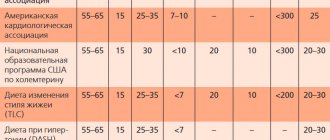Magnesium-Diasporal 300 granules for the preparation of solution for oral administration in 5.0g bags No. 50
Name
Magnesium-Diasporal 300 gran.d/adv. solution for internal use. in pack 5.0g per pack. No. 50
Description
Yellow granules. When 5 g of granules are dissolved in 75 ml of water, a solution with a characteristic odor is formed.
Main active ingredient
Magnesium citrate
Release form
Granules.
Dosage
300 gran.d/prig.r-ra for receiving external. in pack 5.0g
pharmachologic effect
Mineral supplements. Magnesium-based products. ATX code: A12CC04.
Indications for use
Treatment of magnesium deficiency. If you need more information about your condition, ask your doctor for advice.
Directions for use and doses
Adults (>18 years): 1 sachet daily (295.7 mg magnesium). Directions for use: Dissolve the contents of one sachet in half a glass of fruit juice, tea or water and drink half an hour before meals. Children and adolescents: The safety and effectiveness of Magnesium-Diasporal® 300 in children and adolescents has not been established. Use in geriatric practice Dosages in elderly patients are determined by the degree of impairment of their liver and/or kidney function. Use in persons with impaired renal function In patients with moderate impaired renal function, use with caution is recommended. In severe renal impairment (creatinine clearance
Use during pregnancy and lactation
Magnesium-Diasporal® 300 can be used during pregnancy and breastfeeding only on the recommendation of a doctor. There is no evidence of a risk of developmental defects. However, there is very little documented experience with women in early pregnancy.
Precautionary measures
The drug contains sucrose, so patients with rare hereditary fructose intolerance, glucose-galactose malabsorption or sucrase-isomaltase deficiency should not take it. Long-term use (2 weeks or more) may cause damage to teeth. 1 sachet of the drug contains 145.0 mg of sodium bicarbonate or 39.79 mg (1.73 mmol) sodium, which should be taken into account by patients on a diet with limited sodium intake. Use in persons with impaired liver and/or kidney function Use caution in case of moderate renal failure (risk of developing hypermagnesemia). In patients with severe renal impairment (creatinine clearance
Interaction with other drugs
Magnesium salts may increase the activity of neuromuscular blockers (eg, pancuronium bromide, succinylcholine halide). Some medications accelerate the excretion or inhibit the absorption of magnesium and may thus cause magnesium deficiency. Therefore, magnesium dose adjustment may be required when the drug is used concomitantly with the following drugs: diuretics (such as thiazides and furosemide), proton pump inhibitors (such as omeprazole and pantoprazole), platinum derivatives (especially cisplatin), aminoglycoside antibiotics, rapamycin, amphotericin B, foscarnet, cyclosporine A, EGF receptor antagonists (eg, cetuximab and erlotinib) and pentamidine. Magnesium, iron, fluoride and tetracycline ions mutually influence each other's absorption, therefore it is necessary to observe at least a 3-hour interval between taking Magnesium-Diasporal® 300 and preparations containing iron, fluorine and tetracycline. Magnesium weakens the effect of indirect anticoagulants.
Contraindications
Hypersensitivity to the active substance or auxiliary components of the drug listed in the “Composition” section. Severe renal failure (glomerular filtration rate
Compound
One sachet (5.0 g) contains: Active ingredient: Magnesium citrate 1830 mg Equivalent to magnesium content 295.7 mg Excipients: sucrose, anhydrous citric acid, sodium bicarbonate, riboflavin (E101), orange juice flavoring.
Overdose
In the case of healthy kidney function, magnesium toxicity due to overdose of oral magnesium is not expected. Only in cases of severe renal failure can accumulation of magnesium in combination with manifestations of intoxication be observed. Symptoms: With oral therapy with magnesium preparations, an overdose usually does not lead to toxic reactions if renal function is not impaired. Diarrhea may occur, which resolves after reducing the daily dose. Fatigue may be a sign of increased magnesium levels in the blood. Only in cases of severe renal failure with anuria, both oral and parenteral therapy with magnesium preparations can lead to its accumulation and symptoms of intoxication. Depending on the concentration of Mg in plasma (in mmol/l), the following symptoms are observed: 1.5 - decreased blood pressure, nausea, vomiting; 2.5 — depression of the central nervous system; 3.5 — suppression of reflexes, changes on the ECG; 5.0—beginning of respiratory depression; 5.5 - coma; 7.0 - cardiac arrest and respiratory paralysis, anuric syndrome. Treatment: Intravenous administration of calcium (10-20 ml of 10% calcium gluconate solution); the use of loop diuretics, which increase the excretion of magnesium in the urine; symptomatic and supportive therapy. For renal failure: hemodialysis, peritoneal dialysis.
Side effect
The assessment of adverse events is based on the following incidence rates: Very common (? 1/10); often (from ? 1/100 to
Storage conditions
Store out of the reach of children, at a temperature of 15 C to 25 C.
Magnesium is the main anti-stress macronutrient!
Murzaeva Irina Yurievna
Endocrinologist, Preventive Medicine Doctor
March 13, 2018
Not so long ago, I began to get involved in the problems of violations of the most important micro (macro) elements in the human body , and it all started with a search for the causes of autoimmune thyroiditis and the reasons for its prevalence, with a textbook on micro element violations in AIT, then the topic began to expand in search of the causes of “massive hair loss ", including in children, searching for the causes of frequent acute respiratory viral infections in children... more to come. It turned out that the violation of the microelement composition of the human body is a huge science and more than one Russian scientist is engaged in this, but this topic is poorly covered and there is little literature where you can familiarize yourself with it:!: But whoever searches will always find.
Today we start talking about the most important microelements and macroelements for humans.
Magnesium is a mineral that is now actively discussed and advertised ... “magnesium for stress”, “magnesium for irritability”, “magnesium for arimagnesium for seizures” “magnesium for uterine hypertonicity during pregnancy”, etc. MagneB6 and Magnelis are perhaps the most famous magnesium preparations. But this is just the tip of the iceberg, magnesium is not so simple...)
Magnesium is involved in more than 300 enzymatic processes in the body; magnesium, along with sodium and potassium, is a vital macroelement (not even a microelement  ).
).
There is only 24 grams of magnesium in the body (this is not much), but without it, it is not possible to conduct a nerve impulse along nerve fibers, or contract the heart, or contract muscles, or regulate blood pressure; without it, blood coagulation is disrupted, appetite is disrupted, there can be nausea and vomiting and other disorders. A separate book has been written about magnesium; it is a serious scientific work, 800 pages long, entitled “Magnesium and the Diseases of Civilization.” In this article I will not cover all the most important “points of application” of magnesium in the body, sometime later, I’d rather talk about its practical application...
Magnesium is a mineral that is difficult to “accumulate” in the body, it is consumed extremely quickly, and the more stress, the more pronounced the magnesium deficiency... But not all magnesium preparations can successfully replenish its deficiency.... For its absorption and for the best effect in a given situation, it is important to understand what magnesium is “connected” with. I’ll explain in more detail... In order to enter the body, magnesium must be “in the composition” of salt or some organic compound, and the effect of magnesium and digestibility will depend on the nature of “this conductor - salt or organic matter”.
Now about magnesium absorption: Magnesium can exist in the following 15 forms −
magnesium citrate, magnesium malate, magnesium glycinate and bisglycinate, magnesium threonate, magnesium carbonate, magnesium lactate, magnesium taurate, magnesium chloride, magnesium orotate. magnesium sulfate, magnesium chelate, magnesium oxide, glutamate and magnesium aspartate.
And now I’ll decipher:
Magnesium citrate is a magnesium salt of citric acid, the most digestible form of magnesium, used in most well-known drugs - MagneB6 and Magnelis, magnesium citrate solgar, etc., is used more often as an antispasmodic, relieves spasms of the gastrointestinal tract, that is, relieves constipation and impaired bile secretion, good in gastroenterology.
Magnesium malate is a magnesium salt of malic acid that relieves hypomagnesium muscle cramps, relieves fatigue and aluminum intoxication in the body.
Magnesium threonate - in combination with threonic acid, in studies improves long-term and short-term memory, better than magnesium citrate
Magnesium taurate is a non-toxic form of magnesium, very bioavailable, good to use for insulin and leptin resistance, that is, it reduces cravings for overeating sweets and “night gluttons.”
Magnesium oxide - can only be used in cases of reducing high stomach acidity; in other cases it causes severe osmotic diarrhea. Therefore, it is good for constipation.
Magnesium chloride - used primarily as bath salts with a calming effect on the nervous system, but more on that later.
Magnesium orotate is a compound of magnesium with orotic acid, has a predominant effect on the heart muscle, is used for rhythm disturbances and congenital heart disease such as mitral valve prolapse.
Magnesium sulfate - combined with sulfuric acid, used in bath salts (in this form it is practically irreplaceable), in “famous” intravenous injections, mainly to relieve hypertensive crises.
Magnesium aspartate and glutamate - it is better not to use, they belong to the class of endotoxins.
Magnesium glycinate and bisglycinate are a good form of magnesium, mixed with glycine, good for chronic fatigue syndrome and pelvic pain, good because it does not cause a laxative effect.
Magnesium lactate is an artificially synthesized, inexpensive form of magnesium, has a general strengthening effect, as an excipient it is used in most magnesium preparations as an integral part.
Magnesium carbonate - also used for increased stomach acidity, neutralizes the effect of NSAIDs, good for GERD, not for phenylketonuria.
Magnesium chelate is a form of magnesium immersed in an amino acid, facilitating bioavailability. The absorption of the chelate and, accordingly, magnesium from it is 90% , it does not change the acidity of the stomach, unlike forms combined with acids - therefore it is suitable for everyone, but accordingly it is less effective for constipation and other gastrointestinal dyskinesias, but is rarely found in retail sales and is expensive form of magnesium.
Magnesium is in close relationship with calcium, vitamins K2 and D3. The balance of these four elements will help maintain health without complications.
Only for thyroid function, magnesium has a less significant effect than selenium, iodine and iron, for example.
Now about my favorite form of magnesium...... If you don’t want to swallow pills, you don’t need a laxative effect, and your nerves are “on edge and you can’t sleep,” it wouldn’t be a bad idea to carry out an Anti-Stress or Detoxification program—your ideal option—English baths salt, or, simply put, baths with magnesium sulfate 0.5-1 kg of salt per 1 bath and within the first 15 minutes “you will start to fall asleep in the bath.”
Below are questionnaires by which you can determine magnesium deficiency in an adult and a child.



